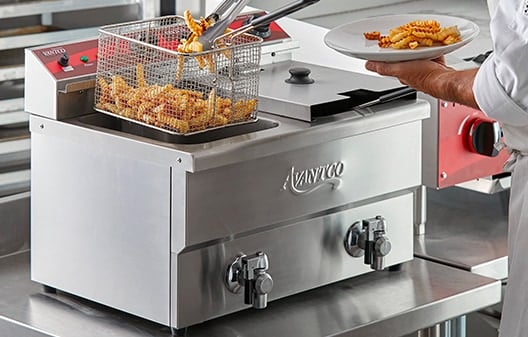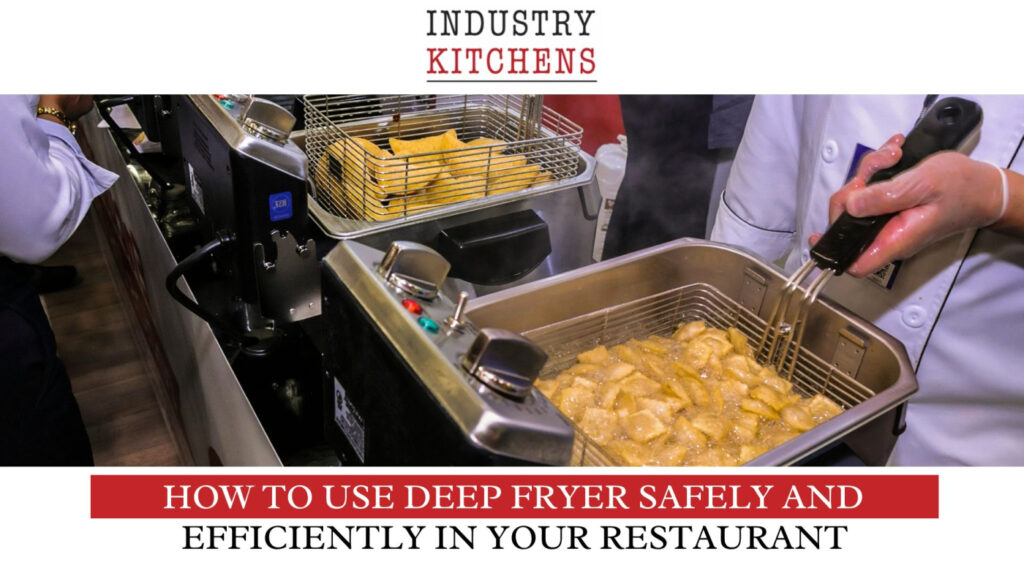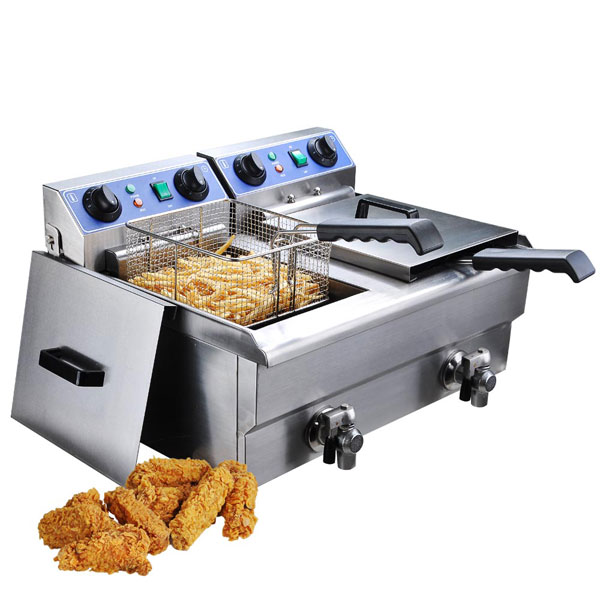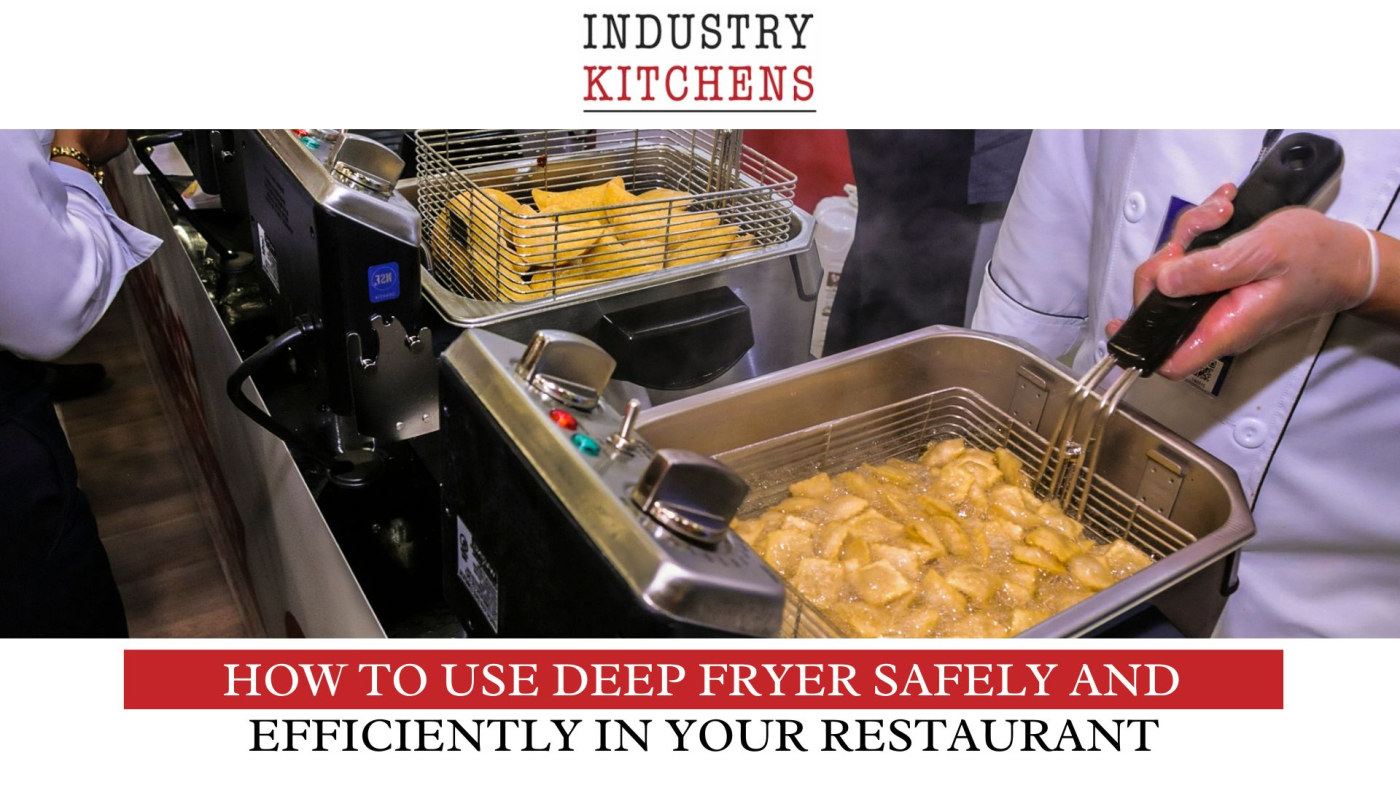In the high-stakes world of restaurant kitchens, where every second counts and customer satisfaction hinges on that perfect crunch, a reliable commercial deep fryer is non-negotiable. Fried foods—think golden French fries, crispy chicken wings, and indulgent mozzarella sticks—remain perennial favorites, driving up menu sales and keeping diners coming back. But not just any fryer will do. Commercial-grade models are built for relentless use, offering superior heat recovery, larger capacities, and energy efficiency that home units simply can’t match. At Tastetrove, we’re passionate about equipping kitchens with tools that elevate flavor and streamline operations. In this comprehensive guide, we’ll explore the best commercial deep fryers for restaurants in 2025, from countertop gems for compact spaces to floor-standing behemoths for high-volume spots. Whether you’re outfitting a bustling diner or a food truck, these picks will help you fry smarter, not harder.
Deep Fryers
Why Invest in a Commercial Deep Fryer?
Commercial deep fryers aren’t just appliances; they’re revenue engines. According to industry insights, fried items can boost check averages by 20-30% in casual dining settings, thanks to their versatility and crowd-pleasing appeal. Unlike stovetop frying, which is labor-intensive and inconsistent, a dedicated fryer ensures uniform results every time—crucial for maintaining brand standards in a restaurant environment.
Key benefits include:
- Speed and Volume: Heat oil to 375°F in minutes and recover temperature quickly after loading, minimizing wait times during peak hours.
- Consistency: Precise thermostats prevent overcooking or sogginess, preserving that signature crunch.
- Efficiency: Modern models feature built-in filtration systems that extend oil life by up to 50%, slashing costs on premium frying oils.
- Safety: Overheat shutoffs, cool-touch exteriors, and spill-proof designs reduce risks in busy kitchens.
For more on how fried apps can transform your menu, check out our https://tastetrove.net/. Investing in the right fryer pays off in reduced waste, happier staff, and loyal customers.
The Deep Fryers are perfect for anyone who loves crispy and golden fried food. Modern Deep Fryers include features like timers and temperature settings for precise cooking. With quality Deep Fryers, you can easily prepare snacks, sides, and full meals. Many Deep Fryers are compact and designed to fit conveniently in any kitchen space. Durable Deep Fryers provide consistent heat for professional-style results every time. Investing in reliable Deep Fryers makes home cooking faster, safer, and more enjoyable.

Types of Commercial Deep Fryers
Navigating the world of commercial fryers starts with understanding the main categories. Each type suits different kitchen layouts, menus, and throughput levels. Broadly, they divide by design (countertop vs. floor), power source (gas vs. electric), and pot style (open pot, tube, or pressure).
The Deep Fryers make it simple to enjoy restaurant-quality food at home. Many Deep Fryers are built with large oil capacities to cook bigger portions. Using modern Deep Fryers, you can fry chicken, seafood, and snacks with consistent results. Compact Deep Fryers are a great option for small kitchens or quick meals. Advanced Deep Fryers often come with safety features like auto shut-off and cool handles. Investing in durable Deep Fryers ensures long-lasting use and delicious meals every time.
Countertop vs. Floor Models
- Countertop Fryers: Compact and portable, these are ideal for small restaurants, bars, or food trucks with limited space. Capacities range from 5-20 lbs of oil, perfect for low-to-medium volume (e.g., 20-50 lbs of fries per hour). They’re electric-heavy for easy plug-and-play installation.
- Floor Models: Robust units on casters for high-volume operations like cafeterias or fast-casual chains. Holding 40-100+ lbs of oil, they crank out 75-200 lbs of food hourly. Available in single or battery configurations (multiple vats side-by-side) for frying diverse items simultaneously.
Gas vs. Electric
- Gas Fryers: Powered by natural gas or propane, these heat faster (often in under 10 minutes) and maintain temps under heavy loads, making them favorites for busy spots. They’re energy-efficient in regions with low gas rates but require ventilation and professional hookup.
- Electric Fryers: Simpler to install (just plug in) and cleaner-burning, with quicker recovery between batches. They’re pricier upfront but excel in consistent, ambient-heat-free performance—great for enclosed kitchens.
Pot Styles
- Open Pot: Versatile for varied foods like fish or veggies; easy to clean but slower recovery.
- Tube-Style: Efficient for high-volume fries or chips, with tubes channeling heat for even distribution.
- Pressure Fryers: Seal in moisture for juicier results (hello, KFC-style chicken); best for proteins but not veggies.
Ventless options with built-in hoods suit non-traditional spaces like mobile units. For a deeper dive, WebstaurantStore’s fryer buying guide breaks it down further.
Key Features to Consider When Choosing a Fryer
Selecting the perfect fryer boils down to your operation’s needs. Start with volume: Estimate daily fried output (e.g., lbs of fries) and multiply by 1.5-2x for oil capacity. A 40-lb fryer handles 60-80 lbs hourly—scale up for surges.
Other must-haves:
- Capacity and Recovery Time: Look for 15-90 lb pots with <3-minute recovery to keep lines moving.
- Filtration Systems: Built-in or portable filters remove debris, extending oil life and flavor. Energy Star-rated models save 10-20% on utilities.
- Controls and Safety: Digital thermostats (up to 400°F), timers, and auto-shutoffs are non-negotiable. Stainless steel construction resists corrosion.
- Energy Efficiency: Infrared burners or insulated pots cut costs; check for rebates.
- Ease of Maintenance: Removable tanks and nickel-plated baskets simplify deep cleans.
Budget? Entry-level countertops start at $500; high-end floor models hit $5,000+. Factor in lifetime costs—durable brands like Henny Penny last 7-10 years with proper care. As one expert notes, “Deep fat fryers are almost a must if you want to satisfy the enormous demand for popular fried foods.” Pro tip: Test oil smoke points—peanut or canola for high-heat frying.
The Deep Fryers are essential kitchen appliances for creating crispy and flavorful dishes. Modern Deep Fryers feature digital controls and adjustable thermostats for perfect frying. With high-quality Deep Fryers, you can prepare French fries, onion rings, and fried chicken easily. Many compact Deep Fryers are designed for quick meals in small kitchens. Large-capacity Deep Fryers are ideal for families who love sharing fried food. Investing in reliable Deep Fryers guarantees convenience, safety, and consistently delicious results.
Top Commercial Deep Fryer Picks for 2025
We’ve scoured reviews, tested specs, and consulted pros to curate these standout models. Prices are approximate; shop around for deals.
Best Countertop: Waring WDF75RC (15 lb, Electric) – $450
This workhorse shines in small setups, frying up to 30 lbs of fries hourly with a hinged element for easy tank removal. Its 30-minute timer and twin baskets handle apps like onion rings flawlessly. Users rave about the stainless steel build and fast 8-minute heat-up. Ideal for bars or cafes; pairs well with our cocktail pairing ideas. Drawback: Single vat limits multi-item frying.
Best for High-Volume: Henny Penny PFG 684 (50 lb per vat, Gas, Dual Battery) – $4,200
Henny Penny dominates with smart filtration that reclaims oil and cuts waste by 40%. Infrared tech ensures even crisping for chicken or seafood, recovering in 2 minutes. Energy-efficient and programmable, it’s a QSR staple. “Their models include advanced filtration systems and energy-efficient designs,” per industry reviews. Perfect for chains; ventless option available.
Best Value Floor Model: Pitco SG18 (70-90 lb, Gas) – $2,800
Pitco’s tube-fired design delivers rapid heat for 100+ lbs hourly, with a cold-zone pot minimizing flavor transfer. Solid stainless build and precise controls make it a budget-friendly beast for diners. Quick install and low maintenance seal the deal. For similar picks, see Vulcan’s fryer lineup.
Best Electric Floor: Frymaster RE14 (40 lb, Electric) – $3,500
Frymaster’s foot-print design maximizes output in tight spaces, with ladder-tube heating for superior recovery. Built-in filtration and easy-lift elements simplify shifts. It’s a top seller for its reliability—up to 70 lbs of wings per hour. Great for eco-conscious spots; Energy Star certified.
Premium Pressure Pick: Ultrafryer Model 18S (65 lb, Gas) – $6,000
For juicy, fast-fried chicken, Ultrafryer’s phased-array exchanger seals in flavors while filtering automatically. Dual infrared burners hit 400°F instantly, yielding 100 lbs hourly. “Fry your best with Ultrafryer commercial deep fryers,” boasts the brand. Luxury investment for steakhouses.
| Model | Type | Capacity (Oil lbs) | Power | Hourly Output (lbs fries) | Price | Best For |
|---|---|---|---|---|---|---|
| Waring WDF75RC | Countertop Electric | 15 | Electric | 30 | $450 | Small bars/cafes |
| Henny Penny PFG 684 | Floor Gas Battery | 50/vat | Gas | 120 | $4,200 | QSR chains |
| Pitco SG18 | Floor Gas | 70-90 | Gas | 100+ | $2,800 | Value diners |
| Frymaster RE14 | Floor Electric | 40 | Electric | 70 | $3,500 | Eco kitchens |
| Ultrafryer 18S | Floor Gas Pressure | 65 | Gas | 100 | $6,000 | Premium proteins |
These selections draw from 2025 reviews emphasizing durability and performance.
Maintenance Tips to Maximize Lifespan
A well-maintained fryer lasts 7-10 years, but neglect leads to breakdowns and off-flavors. Daily: Filter oil post-shift, wipe exteriors, and check temps. Weekly: Boil-out with degreaser (like Fry-Whiz) to dissolve buildup. Monthly: Inspect elements and seals; replace oil if dark or smoky.
Oil savvy: Use high-smoke-point varieties, filter every 4-8 hours, and store cool. Annual pro inspections catch issues early. “Proper daily maintenance only takes a few minutes, but it can save you huge amounts of time and money.” For full protocols, visit Restaurant Equippers’ cleaning guide.
Safety first: Train staff on lockouts and fire suppression. Integrate with our kitchen safety checklist.
Conclusion: Fry Up Success in 2025
Equipping your restaurant with a top-tier commercial deep fryer isn’t just about crispy results—it’s about operational excellence, cost savings, and delighting guests. From the versatile Waring countertop to the powerhouse Henny Penny, these picks cater to every scale. Assess your space, volume, and menu, then pull the trigger. Ready to upgrade? Explore more gear at Tastetrove or consult pros for custom setups. Your next golden batch awaits—happy frying!
Why Invest in a Commercial Deep Fryer?
Commercial deep fryers aren’t just appliances; they’re revenue engines. According to industry insights, fried items can boost check averages by 20-30% in casual dining settings, thanks to their versatility and crowd-pleasing appeal. Unlike stovetop frying, which is labor-intensive and inconsistent, a dedicated fryer ensures uniform results every time—crucial for maintaining brand standards in a restaurant environment.
Key benefits include:
- Speed and Volume: Heat oil to 375°F in minutes and recover temperature quickly after loading, minimizing wait times during peak hours.
- Consistency: Precise thermostats prevent overcooking or sogginess, preserving that signature crunch.
- Efficiency: Modern models feature built-in filtration systems that extend oil life by up to 50%, slashing costs on premium frying oils.
- Safety: Overheat shutoffs, cool-touch exteriors, and spill-proof designs reduce risks in busy kitchens.
For more on how fried apps can transform your menu, check out our guide to profitable restaurant appetizers. Investing in the right fryer pays off in reduced waste, happier staff, and loyal customers.
Types of Commercial Deep Fryers
Navigating the world of commercial fryers starts with understanding the main categories. Each type suits different kitchen layouts, menus, and throughput levels. Broadly, they divide by design (countertop vs. floor), power source (gas vs. electric), and pot style (open pot, tube, or pressure).
Countertop vs. Floor Models
- Countertop Fryers: Compact and portable, these are ideal for small restaurants, bars, or food trucks with limited space. Capacities range from 5-20 lbs of oil, perfect for low-to-medium volume (e.g., 20-50 lbs of fries per hour). They’re electric-heavy for easy plug-and-play installation.
- Floor Models: Robust units on casters for high-volume operations like cafeterias or fast-casual chains. Holding 40-100+ lbs of oil, they crank out 75-200 lbs of food hourly. Available in single or battery configurations (multiple vats side-by-side) for frying diverse items simultaneously.
Gas vs. Electric
- Gas Fryers: Powered by natural gas or propane, these heat faster (often in under 10 minutes) and maintain temps under heavy loads, making them favorites for busy spots. They’re energy-efficient in regions with low gas rates but require ventilation and professional hookup.
- Electric Fryers: Simpler to install (just plug in) and cleaner-burning, with quicker recovery between batches. They’re pricier upfront but excel in consistent, ambient-heat-free performance—great for enclosed kitchens.
Pot Styles
- Open Pot: Versatile for varied foods like fish or veggies; easy to clean but slower recovery.
- Tube-Style: Efficient for high-volume fries or chips, with tubes channeling heat for even distribution.
- Pressure Fryers: Seal in moisture for juicier results (hello, KFC-style chicken); best for proteins but not veggies.
Ventless options with built-in hoods suit non-traditional spaces like mobile units. For a deeper dive, WebstaurantStore’s fryer buying guide breaks it down further.
Key Features to Consider When Choosing a Fryer
Selecting the perfect fryer boils down to your operation’s needs. Start with volume: Estimate daily fried output (e.g., lbs of fries) and multiply by 1.5-2x for oil capacity. A 40-lb fryer handles 60-80 lbs hourly—scale up for surges.
Other must-haves:
- Capacity and Recovery Time: Look for 15-90 lb pots with <3-minute recovery to keep lines moving.
- Filtration Systems: Built-in or portable filters remove debris, extending oil life and flavor. Energy Star-rated models save 10-20% on utilities.
- Controls and Safety: Digital thermostats (up to 400°F), timers, and auto-shutoffs are non-negotiable. Stainless steel construction resists corrosion.
- Energy Efficiency: Infrared burners or insulated pots cut costs; check for rebates.
- Ease of Maintenance: Removable tanks and nickel-plated baskets simplify deep cleans.
Budget? Entry-level countertops start at $500; high-end floor models hit $5,000+. Factor in lifetime costs—durable brands like Henny Penny last 7-10 years with proper care. As one expert notes, “Deep fat fryers are almost a must if you want to satisfy the enormous demand for popular fried foods.” Pro tip: Test oil smoke points—peanut or canola for high-heat frying.
Top Commercial Deep Fryer Picks for 2025
We’ve scoured reviews, tested specs, and consulted pros to curate these standout models. Prices are approximate; shop around for deals. These selections draw from 2025 reviews emphasizing durability and performance.
Best Countertop: Waring WDF75RC (15 lb, Electric) – $450
This workhorse shines in small setups, frying up to 30 lbs of fries hourly with a hinged element for easy tank removal. Its 30-minute timer and twin baskets handle apps like onion rings flawlessly. Users rave about the stainless steel build and fast 8-minute heat-up. Ideal for bars or cafes; pairs well with our cocktail pairing ideas. Drawback: Single vat limits multi-item frying.
Best for High-Volume: Henny Penny PFG 684 (50 lb per vat, Gas, Dual Battery) – $4,200
Henny Penny dominates with smart filtration that reclaims oil and cuts waste by 40%. Infrared tech ensures even crisping for chicken or seafood, recovering in 2 minutes. Energy-efficient and programmable, it’s a QSR staple. “Their models include advanced filtration systems and energy-efficient designs,” per industry reviews. Perfect for chains; ventless option available.
Best Value Floor Model: Pitco SG18 (70-90 lb, Gas) – $2,800
Pitco’s tube-fired design delivers rapid heat for 100+ lbs hourly, with a cold-zone pot minimizing flavor transfer. Solid stainless build and precise controls make it a budget-friendly beast for diners. Quick install and low maintenance seal the deal. For similar picks, see Vulcan’s fryer lineup.
Best Electric Floor: Frymaster RE14 (40 lb, Electric) – $3,500
Frymaster’s foot-print design maximizes output in tight spaces, with ladder-tube heating for superior recovery. Built-in filtration and easy-lift elements simplify shifts. It’s a top seller for its reliability—up to 70 lbs of wings per hour. Great for eco-conscious spots; Energy Star certified.

Premium Pressure Pick: Ultrafryer Model 18S (65 lb, Gas) – $6,000
For juicy, fast-fried chicken, Ultrafryer’s phased-array exchanger seals in flavors while filtering automatically. Dual infrared burners hit 400°F instantly, yielding 100 lbs hourly. “Fry your best with Ultrafryer commercial deep fryers,” boasts the brand. Luxury investment for steakhouses.
| Model | Type | Capacity (Oil lbs) | Power | Hourly Output (lbs fries) | Price | Best For |
|---|---|---|---|---|---|---|
| Waring WDF75RC | Countertop Electric | 15 | Electric | 30 | $450 | Small bars/cafes |
| Henny Penny PFG 684 | Floor Gas Battery | 50/vat | Gas | 120 | $4,200 | QSR chains |
| Pitco SG18 | Floor Gas | 70-90 | Gas | 100+ | $2,800 | Value diners |
| Frymaster RE14 | Floor Electric | 40 | Electric | 70 | $3,500 | Eco kitchens |
| Ultrafryer 18S | Floor Gas Pressure | 65 | Gas | 100 | $6,000 | Premium proteins |
Maintenance Tips to Maximize Lifespan
A well-maintained fryer lasts 7-10 years, but neglect leads to breakdowns and off-flavors. Daily: Filter oil post-shift, wipe exteriors, and check temps. Weekly: Boil-out with degreaser (like Fry-Whiz) to dissolve buildup. Monthly: Inspect elements and seals; replace oil if dark or smoky.
Oil savvy: Use high-smoke-point varieties, filter every 4-8 hours, and store cool. Annual pro inspections catch issues early. “Proper daily maintenance only takes a few minutes, but it can save you huge amounts of time and money.” For full protocols, visit Restaurant Equippers’ cleaning guide.
Safety first: Train staff on lockouts and fire suppression. Integrate with our kitchen safety checklist.
Frequently Asked Questions (FAQs)
Got questions about outfitting your kitchen with a commercial deep fryer? We’ve compiled answers to the most common queries based on industry expertise to help you decide.
What’s the difference between gas and electric commercial deep fryers?
Gas fryers heat up faster (under 10 minutes) and maintain temperatures better under heavy loads, making them ideal for high-volume spots where natural gas is affordable. They offer quicker recovery times but require ventilation and professional installation. Electric fryers are easier to set up—just plug in—and produce less ambient heat, keeping kitchens cooler. They’re more energy-efficient for consistent, lower-volume frying and simpler to maintain with fewer components. Choose based on your fuel access and menu demands.
How do I choose the right capacity for my restaurant?
Estimate your peak-hour fried food output (e.g., 50 lbs of fries) and select a fryer with 1.5-2x that in oil capacity to account for recovery. Countertop models (10-20 lbs) suit small ops like food trucks; floor models (40-100+ lbs) handle chains. Oversizing wastes energy; undersizing slows service.
What type of oil is best for commercial deep frying?
Opt for high smoke-point oils like peanut (450°F) or canola (400°F) for neutral flavor and longevity. Avoid butter or olive oil, which burn easily. Rotate oils every 4-8 hours and filter to extend life by 50%. For a full breakdown, see WebstaurantStore’s oil guide.
How often should I clean my commercial deep fryer?
Daily: Wipe surfaces and filter oil. Weekly: Deep clean the tank with a degreaser. Monthly: Check seals and elements. Neglect leads to flavor crossover and breakdowns. Ventless models need extra attention to built-in hoods.
Are there safety features I should look for in a fryer?
Yes—prioritize models with automatic shutoffs at 400°F+, thermal overload protection, and cool-touch exteriors. Use Class K extinguishers for oil fires (never water), and train staff on PPE. Modern units include basket lifts to prevent splatters.
Can I use a commercial deep fryer in a food truck?
Absolutely—compact countertop or ventless models fit tight spaces without full exhaust. Ensure propane compatibility for gas units and check local regs for mobility.
Recommended Products and Accessories
Elevate your frying game with these must-have products and add-ons, available from trusted suppliers. We’ve focused on durable, restaurant-proven items to complement your new fryer.
Deep Fryer Oils
- LouAna Peanut Oil (35 lb Pail) – $25: High smoke point for crispy results; neutral taste perfect for mixed menus. Shop at WebstaurantStore.
- Viva Farms Canola Oil (35 lb) – $20: Affordable, heart-healthy option with 400°F stability. Great for veggies and fish.
Filtration Systems
- Frymaster Portable Filtration Unit – $1,200: Connects to any floor model; removes debris to extend oil life 3x. Energy Star-rated for eco-savings.
- Henny Penny Built-in Filter Kit – $800: Seamless integration for PFG models; auto-pumps oil for quick changes.
Baskets and Accessories
- Nickel-Plated Twin Basket Set (15 lb) – $50: Fits Waring countertops; rust-resistant for daily use. Available at Restaurant Equippers.
- Stainless Steel Skimmer – $15: Essential for removing debris mid-shift; ergonomic handle reduces strain.
Cleaning Supplies
- Ecolab Fryer Cleaner (1 gal) – $30: Breaks down carbonized oil; safe for stainless steel. Use weekly for shine.
- Boil-Out Solution Kit – $25: Dissolves buildup in pots; includes gloves and scrubbers.
| Accessory | Price | Compatible With | Key Benefit |
|---|---|---|---|
| LouAna Peanut Oil | $25 | All Models | High Smoke Point |
| Frymaster Filter Unit | $1,200 | Floor Fryers | Oil Life Extension |
| Twin Basket Set | $50 | Countertops | Rust-Resistant |
| Ecolab Cleaner | $30 | All | Easy Deep Clean |
These accessories can cut operational costs by 20-30% through better maintenance. For bulk deals, visit Central Restaurant’s fryer section.

Conclusion: Fry Up Success in 2025
Equipping your restaurant with a top-tier commercial deep fryer isn’t just about crispy results—it’s about operational excellence, cost savings, and delighting guests. From the versatile Waring countertop to the powerhouse Henny Penny, these picks cater to every scale. Assess your space, volume, and menu, then pull the trigger. Ready to upgrade? Explore more gear at Tastetrove or consult pros for custom setups. Your next golden batch awaits—happy frying!
